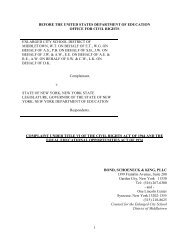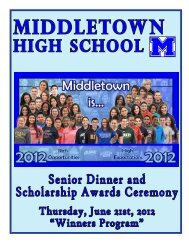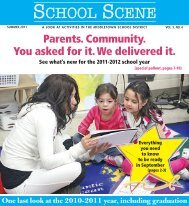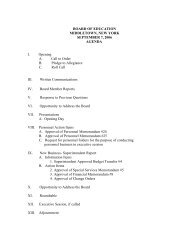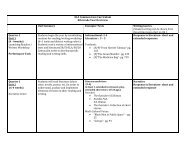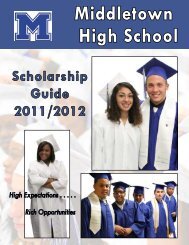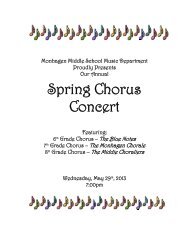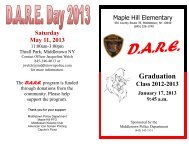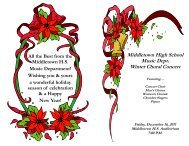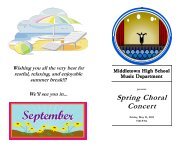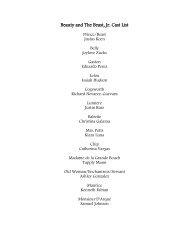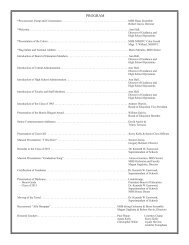3-5 Writing Rubric Student Friendly - Middletown City School District
3-5 Writing Rubric Student Friendly - Middletown City School District
3-5 Writing Rubric Student Friendly - Middletown City School District
- No tags were found...
You also want an ePaper? Increase the reach of your titles
YUMPU automatically turns print PDFs into web optimized ePapers that Google loves.
MIDDLETOWN 3-5 WRITING RUBRIC – <strong>Student</strong> <strong>Friendly</strong> <strong>Rubric</strong>Key Question: Did I talk about only one big idea? Did I share my idea in a unique way?Meaning/Development: Theextent to which the responseexhibits understanding andinterpretation of the task.IDEASExperimentingThe writer is just figuring out what theywant to say. The writer does not show that they know thetopic well enough. It’s hard to picture much. The writer does not have a clear idea and maystill be brainstorming.DevelopingIt has its intriguing moments, but thedevelopment is still basic or general. The topic might be too big. The piece could use some more details. Ideas may be clearer in the writer’s head than onpiece. The information seems pretty general rather thanspecific. The reader might still have some questions. The writer stayed on topic, but doesn’t really havea message.Key Question: Does the organizational structure enhance the ideas and make them easier to understand?Organization: The extentto which the responseexhibits direction, shape,and coherence.ORGANIZATIONExperimentingWhere are we headed? You could get dizzy trying to follow this. Beginning? Oops… The ideas are mixed up and confusing. It doesn’t have a real ending. It just stops. No title (if asked).DevelopingYou can follow it pretty well. There is a beginning. Most details fit where they are put. The piece has an ending, but needs some work. The piece has a title that works.ExperiencedIt is clear, focused, jam-packed with details,and holds the reader’s attention. The topic is small enough to handle. Interesting tidbits give the reader importantinformation. Accurate details support the main idea. You can tell the writer knows a LOT about thistopic. The writer thought of readers’ questions andanswered them. This paper shows some insight (a deepermessage)!ExperiencedClear and fascinating direction makesreading a BREEZE. The beginning gets you hooked. Every detail is in the right place. You won’t feel lost. The piece ends just at the right spot, and it leavesyou thinking. Creative and original title.Key Question: Would I keep reading this piece it if were longer?Language: The extent to which theresponse reveals an awareness of audienceand purpose through effective use of words,sentence structure, and sentence variety.VOICEExperimentingThe writer is not comfortable letting thereal him/her show. It could be hard to tell who wrote this. The writer kept his/her feelings in check. Safe and careful – that’s this paper. Audience? What audience? No point of view is reflected.DevelopingWhat the writer truly thinks and feels showsup sometimes. Pleasant and friendly, but cautious. The writer’s personality pokes through here andthere. The writer plays it safe and doesn’t risk showingtoo much about them. Narrative is sincere, but not passionate; expositoryor persuasive might not be too convincing. The writer is right on the edge of finding his/hervoice: strong in places, fuzzy in others.ExperiencedThe writer has put a personal stamp on thispaper. The piece speaks to the reader. The piece shines with personality and confidence. Tone and voice are appropriate for the purposeand audience. Narrative seems honest, personal, and writtenfrom the heart. Expository or persuasive showsstrong feelings about the topic, showing why thereader should know or care about it. This will make the reader think. They’ll want totalk to others about it.
Key Question: Do the words and phrases create vivid pictures and stay in my mind?Language Use: The extent to which theresponse reveals and awareness of audienceand purpose through effective use of words,sentence structure, and sentence variety.WORD CHOICEExperimentingThe reader is likely to ask, “Huh?” Fuzzy words and phrases are used. Some repeated words and phrases are used. The writer misused a word or two. The vocabulary is limited and words aremisused.Key Question: Can I FEEL the words and phrases flow together as I read it?Language Use: The extent to which theresponse reveals an awareness of audienceand purpose through effective use of words,sentence structure, and sentence variety.SENTENCE FLUENCYExperimentingI have to admit, it’s a challenge to readaloud. The sentences are choppy, incomplete,rambling, and/or awkward; they don’t soundnatural. The sentences all seem to be the same length. Lots of sentences start the same way andfollow the same pattern. Too many connectives (and, so, but, then,because, etc.) or so few, it’s confusing. You probably wouldn’t want to read thisaloud.DevelopingIt might not peak your imagination, but heyitgets the message across. Words are used correctly, but are not very original. The words communicate, but they hardly evercreate pictures in your mind. The writer might have over used the thesaurus. Passive verbs, everyday nouns, adjectives andadverbs. Not much revision was done. It reads as though itwere pretty much the first things that popped intothe writer’s head. It’s functional, with only a moment or two ofsparkle.DevelopingThe sentences are clear and readable. The sentences get the job done but are not musical. Some sentences could be combined; others shouldbe cut in two. Some sentence beginnings are interesting andvaried. The reader may not see how the sentences connect. When reading aloud, some parts are smooth andnatural; other parts are a bit bumpy.ExperiencedThe writer picked just the right words toexpress the ideas and feelings. Every word seems exactly right; specific andaccurate. The words create pictures that stay in your mind. Colorful, fresh and snappy-yet nothing’soverdone. Striking words and phrases catch your eye. Lively verbs, precise nouns and descriptivemodifiers.ExperiencedThe sentences have flow and rhythm, andvary in length. They’re a real treat to readaloud. The sentence structure helps make the meaningclear. Sentences vary in length and structure. Some arelong and stretchy; others are short and snappy. Carefully picked sentence beginnings add varietyand energy. The writing has a tempo. It’s easy to read aloud.
Key Question: How much editing would have to be done to be ready to share with an outside source?Conventions/Mechanics: The extent towhich the response exhibits conventionalspelling, punctuation, paragraphing,capitalization, grammar, and usage.CONVENTIONSExperimentingRead once to decode, then again formeaning. Many spelling mistakes. Punctuation errors make reading tough. The writer has forgotten some capitals, othersaren’t needed. This piece needs a lot of editing.DevelopingSome bothersome mistakes show up when Iread carefully. The spelling is correct on SIMPLE words. The reader might stumble over some incorrectpunctuation. Capitals are mostly there. The grammar is O.K., though not award winning. The writer tried to use paragraphs, although itmight not have been done correctly. Some editing is still needed to get this piece readyto publish.ExperiencedThe writer made so few errors, it would be asnap getting this ready to publish. Spelling to knock your socks off. Great punctuation guides you through text. Capitals are in the right places. You won’t be distracted by incorrect grammarand usage. Paragraphs are indented (or spaced) and in theright places. This piece is VERY close to being ready topublish.Key Question:ExperimentingThe message is confused due to problemswith the presentation of the text.DevelopingMy message gets through in this format.ExperiencedThis is pleasing to the eye. The form andpresentation enhance understanding.PRESENTATION Text is difficult to read and understand. Wild use of fonts and font sizes distracts thereader. The spacing is random and confusing. There may be little or no white space. There are no markers (titles, side heads, pagenumbering, bullets) to guide reader; may bemisleading. Handwriting is readable, although some parts maybe easier to read than others. Experimentation with fonts and font sizes issometimes successful, sometimes fussy orcluttered. Consistent spacing is used, but there may havebeen a better choice (e.g., single, double, or triplespacing) for spacing and/or margins. Markers (titles, side heads, page numbering,bullets) are not useful to their fullest potential. Limited connection between text and visuals. If handwritten, the slant, letter formation, andspacing are uniform and easy to read. If word-processed, fonts and font sizes invite thereader in. There’s just the right balance of text and whitespace. Markers (titles, side heads, page numbering,bullets) help make the information clear to thereader. If used, illustrations, charts, graphs, maps, tables,etc. support and clarify important information.



